Abstract
The purpose of this study was to determine the prevalence of perimenstrual symptoms (PMS) in a free-living population of US women and to determine if prevalence estimates varied with parity, contraceptive status, characteristics of the menstrual cycle, and selected demographic variables. We identified all households from a census listing for five southeastern city neighborhoods that offered variation in racial composition and socioeconomic status. We ascertained all households in which there was one nonpregnant woman between the ages of 18 and 35 years per household. Of the 241 eligible women, 179 (74 per cent) participated in the study. Trained interviewers administered the Moos Menstrual Distress Questionnaire (MDQ) and other demographic measures to women between March and July 1979. Symptoms with a prevalence greater than 30 per cent included weight gain, headache, skin disorders, cramps, anxiety, backache, fatigue, painful breasts, irritability, mood swings, depression, or tension. Only 2 to 8 per cent of women found most of these severe or disabling. The exceptions were severe cramps reported by 17 per cent of women and severe premenstrual and menstrual irritability by 12 per cent. Cramps, backaches, fatigue, and tension were most prevalent during the menstruum; weight gain, skin disorders, painful breasts, swelling, irritability, mood swings, and depression were more prevalent in the premenstruum. Parity, oral contraceptive use, age, employment, education, and income were negatively associated with selected PMS. Use of an IUD, having long menstrual cycles, long menstrual flow, or heavy menstrual flow, and being able to predict the next period were positively associated with selected PMS. Race had both positive and negative effects on PMS.
Full text
PDF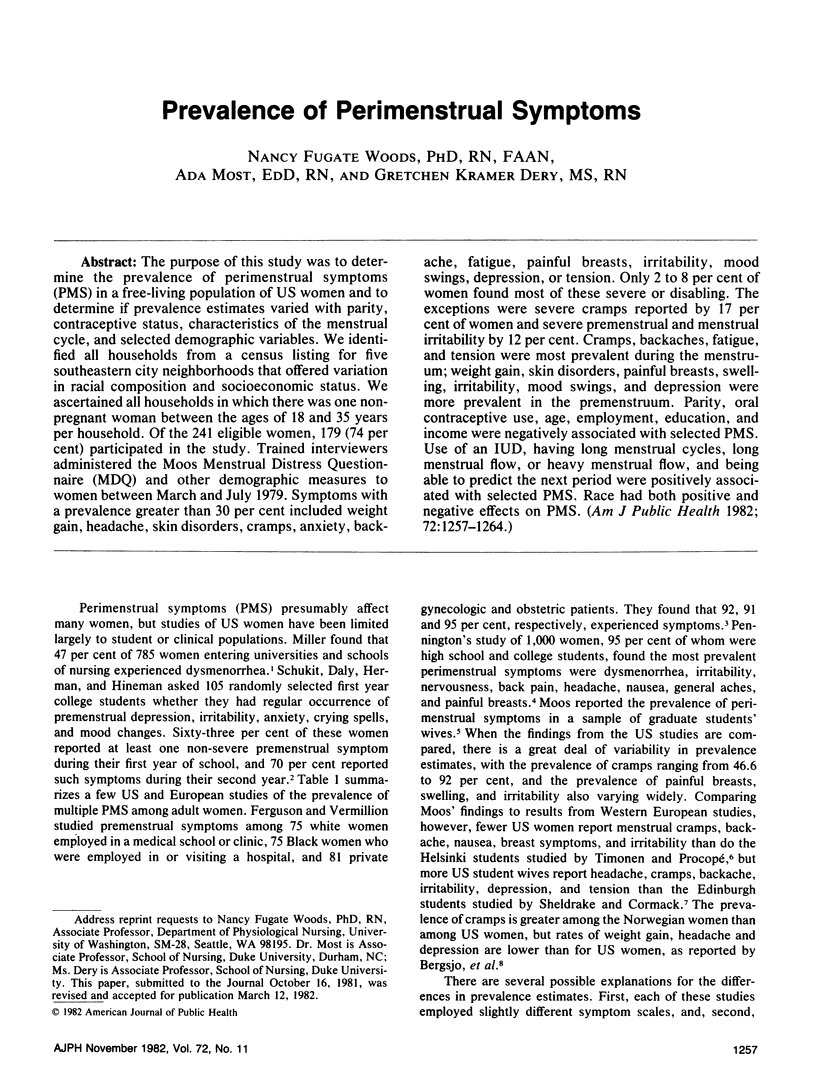
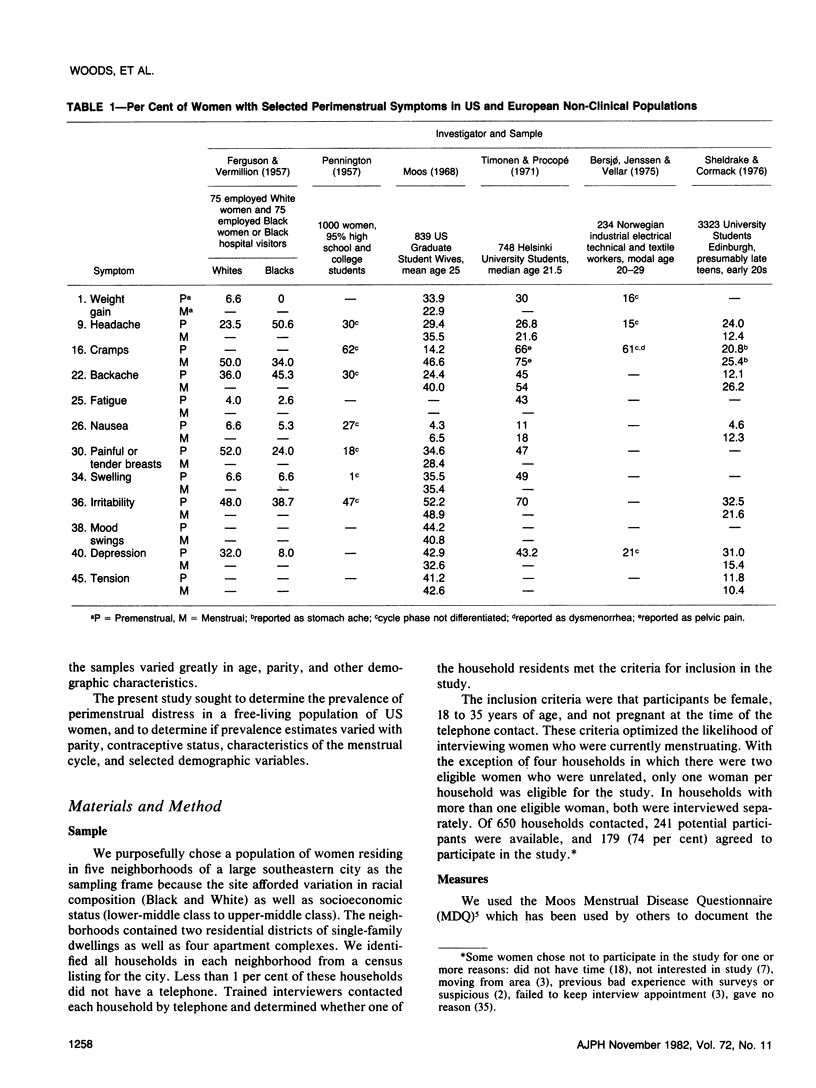
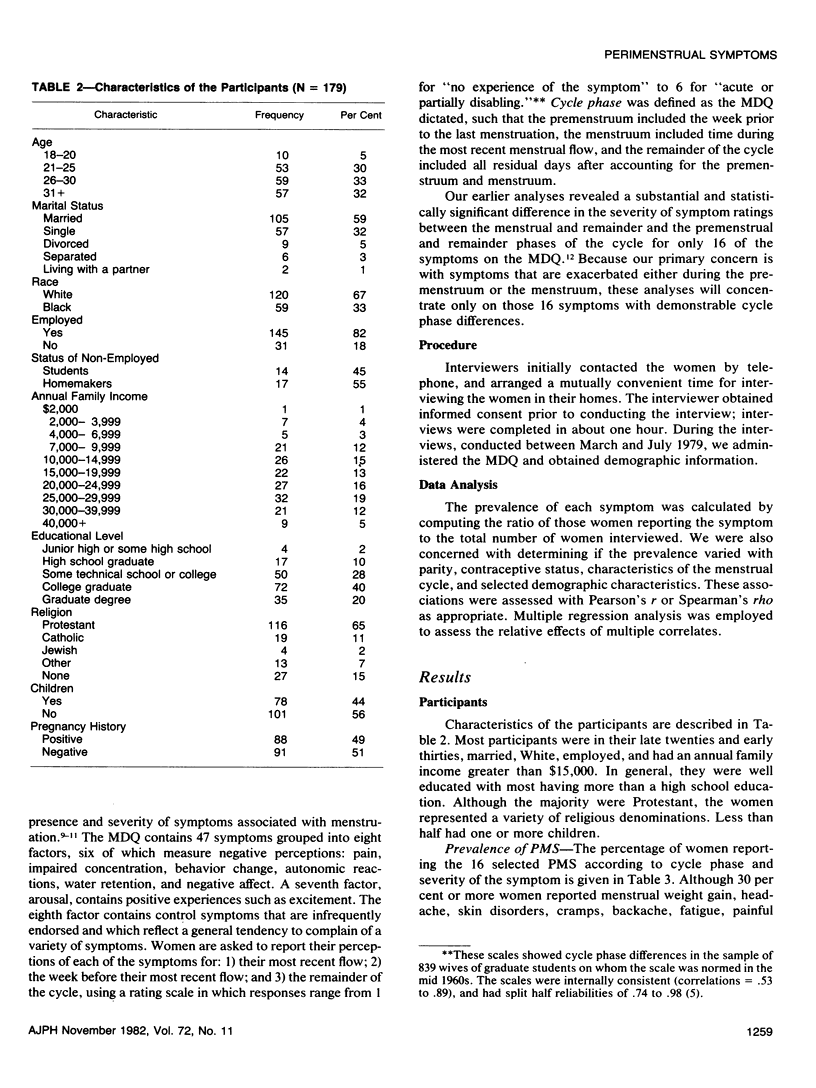
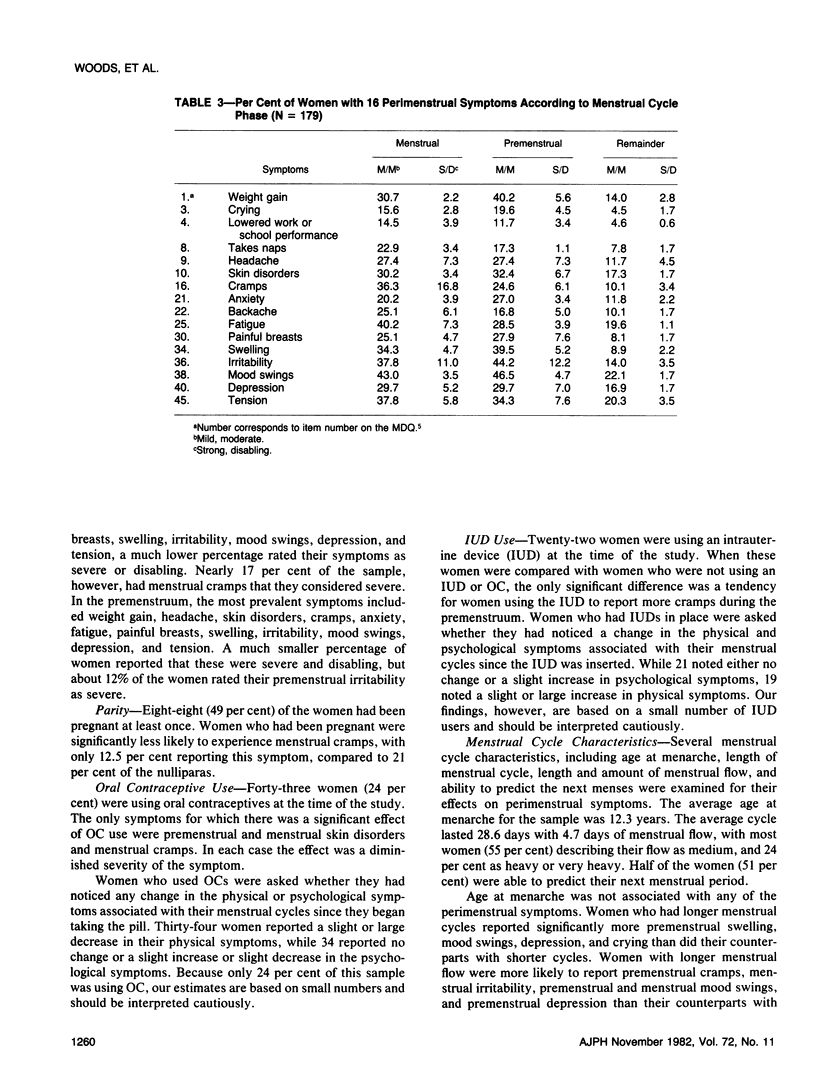
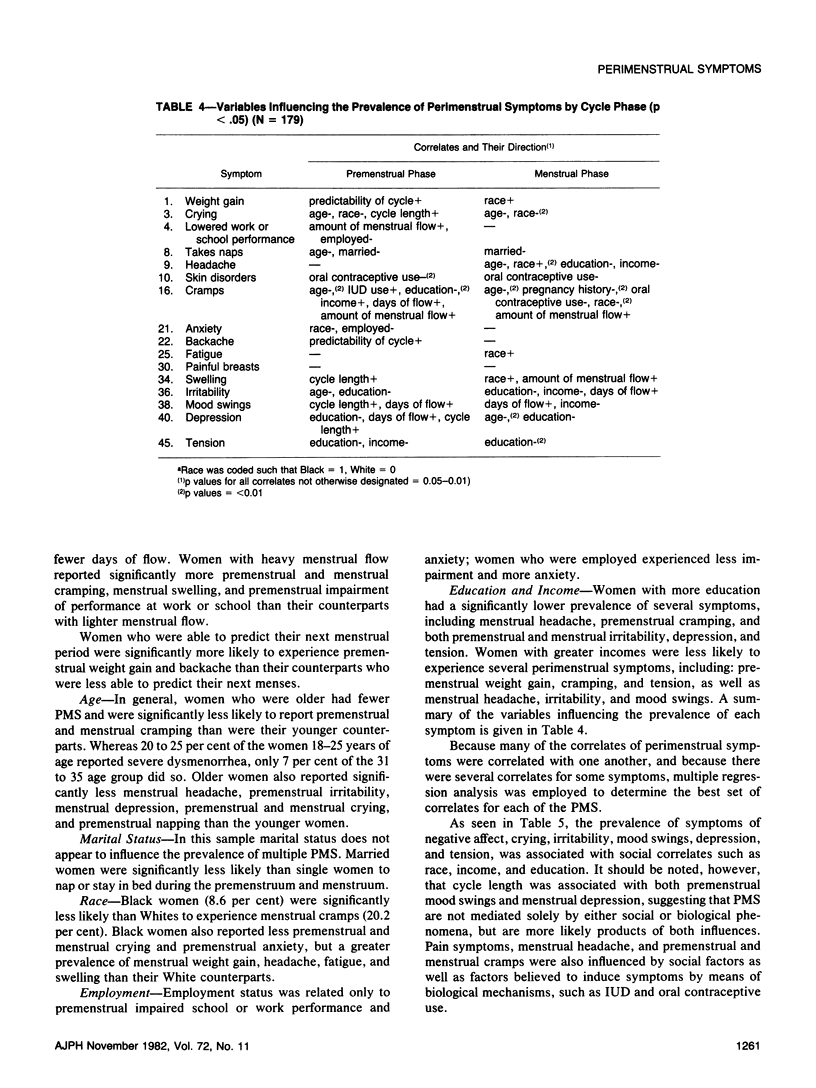
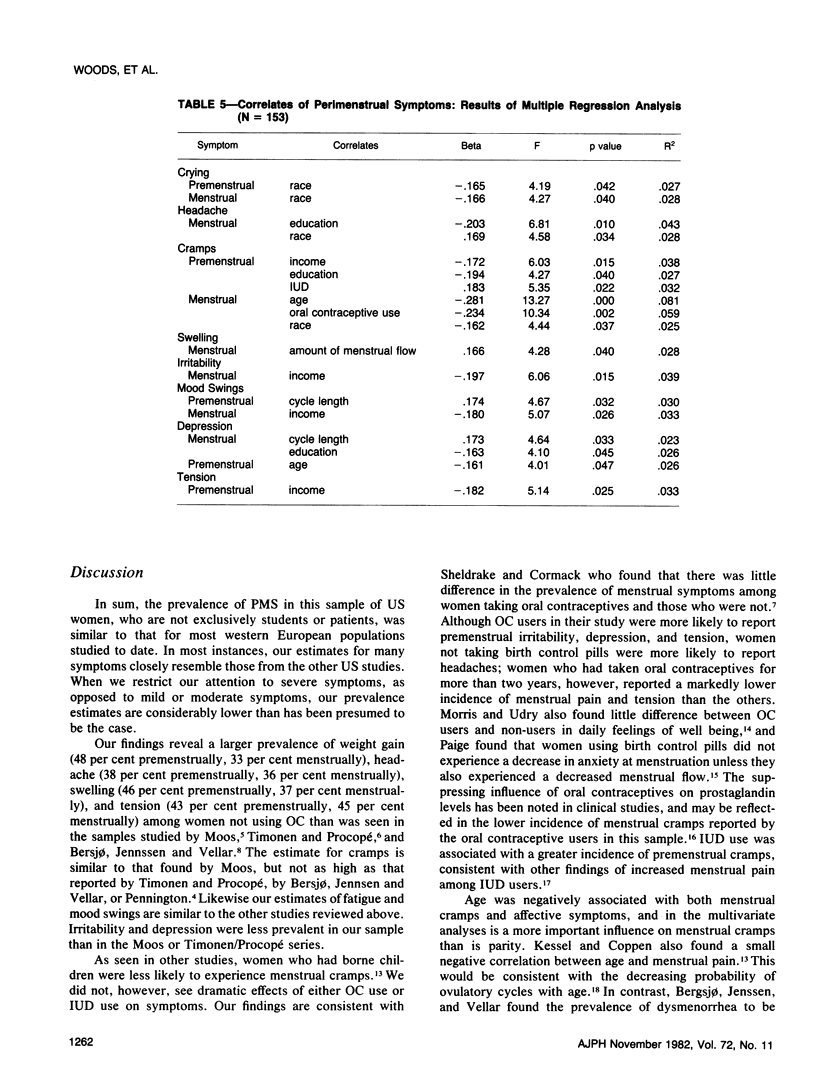
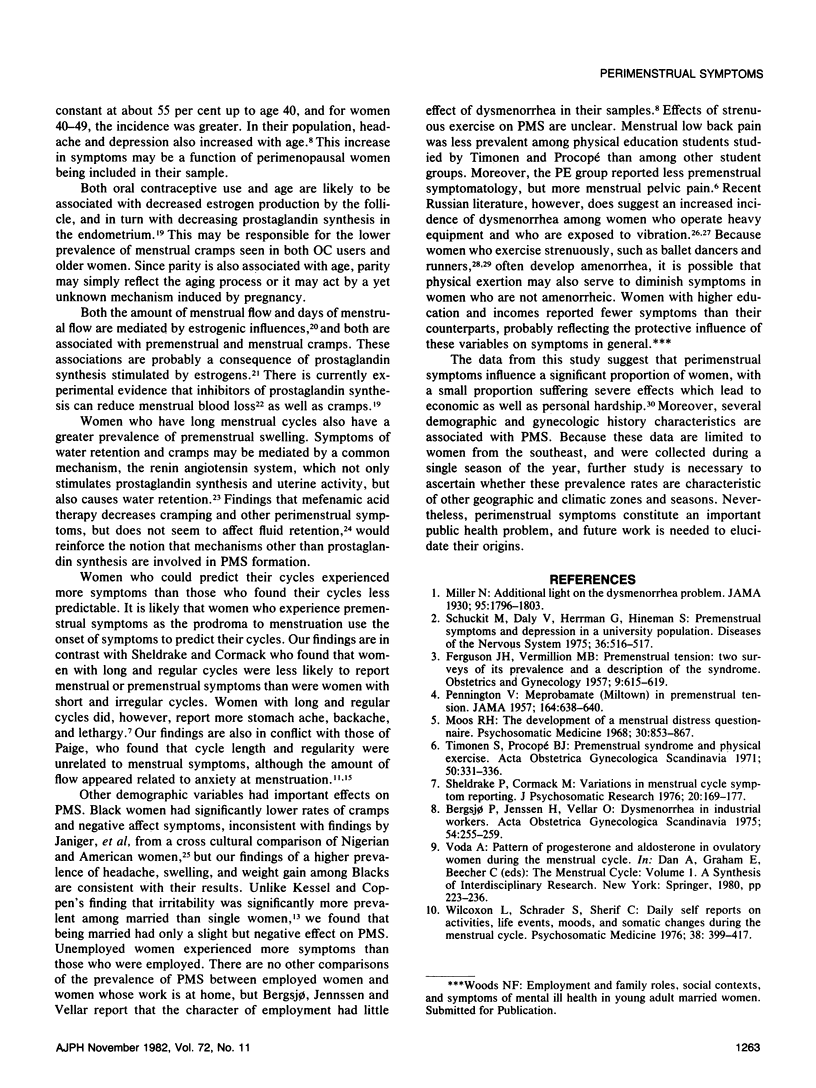

Selected References
These references are in PubMed. This may not be the complete list of references from this article.
- Abraham G. E. Primary dysmenorrhea. Clin Obstet Gynecol. 1978 Mar;21(1):139–145. doi: 10.1097/00003081-197803000-00011. [DOI] [PubMed] [Google Scholar]
- Bergsjo P., Jenssen H., Vellar O. D. Dysmenorrhea in industrial workers. Acta Obstet Gynecol Scand. 1975;54(3):255–259. doi: 10.3109/00016347509157772. [DOI] [PubMed] [Google Scholar]
- Chan W. Y., Hill J. C. Determination of menstrual prostaglandin levels in non-dysmenorrheic and dysmenorrheic subjects. Prostaglandins. 1978 Feb;15(2):365–375. doi: 10.1016/0090-6980(78)90176-4. [DOI] [PubMed] [Google Scholar]
- FERGUSON J. H., VERMILLION M. B. Premenstrual tension; two surveys of its prevalance and a description of the syndrome. Obstet Gynecol. 1957 May;9(5):615–619. [PubMed] [Google Scholar]
- Feicht C. B., Johnson T. S., Martin B. J., Sparkes K. E., Wagner W. W., Jr Secondary amenorrhoea in athletes. Lancet. 1978 Nov 25;2(8100):1145–1146. doi: 10.1016/s0140-6736(78)92294-8. [DOI] [PubMed] [Google Scholar]
- Frisch R. E., Wyshak G., Vincent L. Delayed menarche and amenorrhea in ballet dancers. N Engl J Med. 1980 Jul 3;303(1):17–19. doi: 10.1056/NEJM198007033030105. [DOI] [PubMed] [Google Scholar]
- Janiger O., Riffenburgh R., Kersh R. Cross cultural study of premenstrual symptoms. Psychosomatics. 1972 Jul-Aug;13(4):226–235. doi: 10.1016/S0033-3182(72)71414-0. [DOI] [PubMed] [Google Scholar]
- KESSEL N., COPPEN A. The prevalence of common menstrual symptoms. Lancet. 1963 Jul 13;2(7298):61–64. doi: 10.1016/s0140-6736(63)90063-1. [DOI] [PubMed] [Google Scholar]
- Moos R. H. The development of a menstrual distress questionnaire. Psychosom Med. 1968 Nov-Dec;30(6):853–867. doi: 10.1097/00006842-196811000-00006. [DOI] [PubMed] [Google Scholar]
- Morris N. M., Udry J. R. Contraceptive pills and day-by-day feelings of well-being. Am J Obstet Gynecol. 1972 Jul 15;113(6):763–765. doi: 10.1016/0002-9378(72)90555-8. [DOI] [PubMed] [Google Scholar]
- PENNINGTON V. M. Meprobamate (miltown) in premenstrual tension. J Am Med Assoc. 1957 Jun 8;164(6):638–640. doi: 10.1001/jama.1957.02980060014004. [DOI] [PubMed] [Google Scholar]
- Paige K. E. Effects of oral contraceptives on affective fluctuations associated with the menstrual cycle. Psychosom Med. 1971 Nov-Dec;33(6):515–537. doi: 10.1097/00006842-197111000-00005. [DOI] [PubMed] [Google Scholar]
- Reading A. E., Newton J. R. A comparison of primary dysmenorrhoea and intrauterine device related pain. Pain. 1977 Jun;3(3):265–276. doi: 10.1016/0304-3959(77)90007-0. [DOI] [PubMed] [Google Scholar]
- Schuckit M. A., Daly V., Herrman G., Hineman S. Premenstrual symptoms and depression in a university population. Dis Nerv Syst. 1975 Sep;36(9):516–517. [PubMed] [Google Scholar]
- Sheldrake P., Cormack M. Variations in menstrual cycle symptom reporting. J Psychosom Res. 1976;20(3):169–177. doi: 10.1016/0022-3999(76)90017-9. [DOI] [PubMed] [Google Scholar]
- Sherman B. M., Wallace R. B., Treloar A. E. The menopausal transition: endocrinological and epidemiological considerations. J Biosoc Sci Suppl. 1979;(6):19–35. doi: 10.1017/s0021932000024287. [DOI] [PubMed] [Google Scholar]
- Sherman B. M., West J. H., Korenman S. G. The menopausal transition: analysis of LH, FSH, estradiol, and progesterone concentrations during menstrual cycles of older women. J Clin Endocrinol Metab. 1976 Apr;42(4):629–636. doi: 10.1210/jcem-42-4-629. [DOI] [PubMed] [Google Scholar]
- Smith S. K., Abel M. H., Kelly R. W., Baird D. T. A role for prostacyclin (PGi2) in excessive menstrual bleeding. Lancet. 1981 Mar 7;1(8219):522–524. doi: 10.1016/s0140-6736(81)92862-2. [DOI] [PubMed] [Google Scholar]
- Timonen S., Procopé B. J. Premenstrual syndrome and physical exercise. Acta Obstet Gynecol Scand. 1971;50(4):331–337. doi: 10.3109/00016347109157334. [DOI] [PubMed] [Google Scholar]
- Wilcoxon L. A., Schrader S. L., Sherif C. W. Daily self-reports on activities, life events, moods, and somatic changes during the menstrual cycle. Psychosom Med. 1976 Nov-Dec;38(6):399–417. doi: 10.1097/00006842-197611000-00005. [DOI] [PubMed] [Google Scholar]
- Wood C., Jakubowicz D. The treatment of premenstrual symptoms with mefenamic acid. Br J Obstet Gynaecol. 1980 Jul;87(7):627–630. doi: 10.1111/j.1471-0528.1980.tb05018.x. [DOI] [PubMed] [Google Scholar]
- Ylikorkala O., Dawood M. Y. New concepts in dysmenorrhea. Am J Obstet Gynecol. 1978 Apr 1;130(7):833–847. doi: 10.1016/0002-9378(78)90019-4. [DOI] [PubMed] [Google Scholar]


